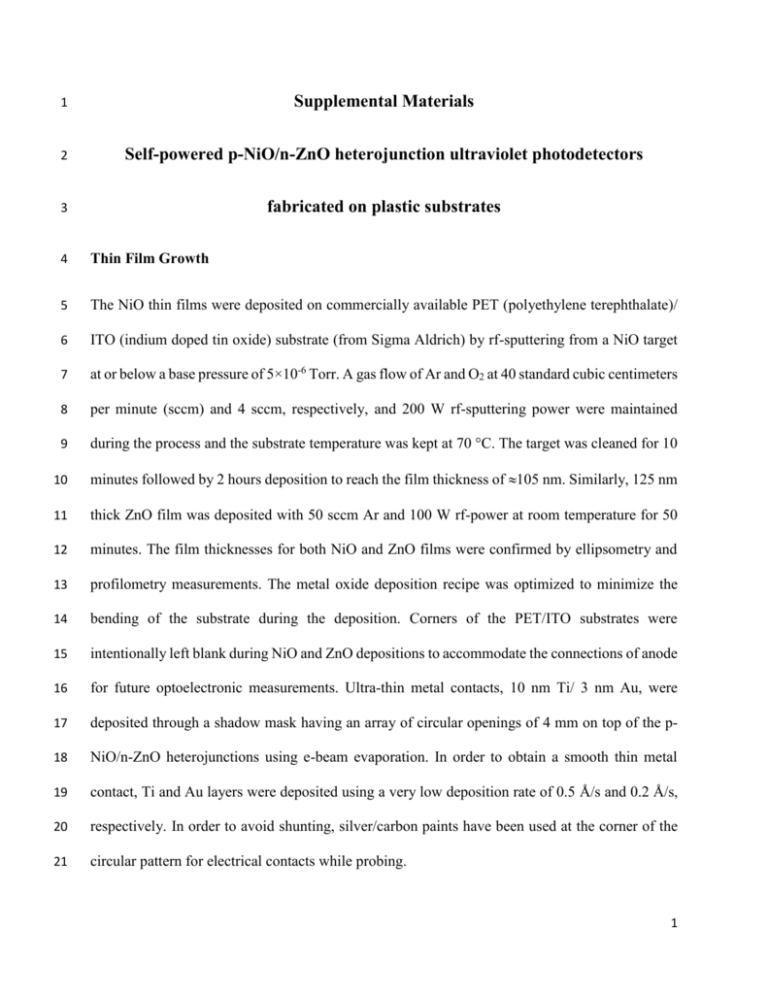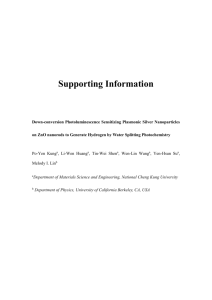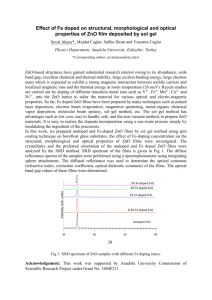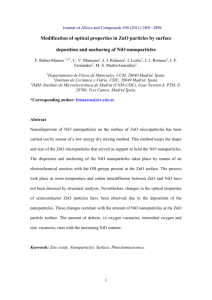Supplemental Materials
advertisement

1 Supplemental Materials 2 Self-powered p-NiO/n-ZnO heterojunction ultraviolet photodetectors 3 fabricated on plastic substrates 4 Thin Film Growth 5 The NiO thin films were deposited on commercially available PET (polyethylene terephthalate)/ 6 ITO (indium doped tin oxide) substrate (from Sigma Aldrich) by rf-sputtering from a NiO target 7 at or below a base pressure of 5×10-6 Torr. A gas flow of Ar and O2 at 40 standard cubic centimeters 8 per minute (sccm) and 4 sccm, respectively, and 200 W rf-sputtering power were maintained 9 during the process and the substrate temperature was kept at 70 °C. The target was cleaned for 10 10 minutes followed by 2 hours deposition to reach the film thickness of 105 nm. Similarly, 125 nm 11 thick ZnO film was deposited with 50 sccm Ar and 100 W rf-power at room temperature for 50 12 minutes. The film thicknesses for both NiO and ZnO films were confirmed by ellipsometry and 13 profilometry measurements. The metal oxide deposition recipe was optimized to minimize the 14 bending of the substrate during the deposition. Corners of the PET/ITO substrates were 15 intentionally left blank during NiO and ZnO depositions to accommodate the connections of anode 16 for future optoelectronic measurements. Ultra-thin metal contacts, 10 nm Ti/ 3 nm Au, were 17 deposited through a shadow mask having an array of circular openings of 4 mm on top of the p- 18 NiO/n-ZnO heterojunctions using e-beam evaporation. In order to obtain a smooth thin metal 19 contact, Ti and Au layers were deposited using a very low deposition rate of 0.5 Å/s and 0.2 Å/s, 20 respectively. In order to avoid shunting, silver/carbon paints have been used at the corner of the 21 circular pattern for electrical contacts while probing. 1 1 Characterization 2 The surface morphology and roughness of the deposited NiO and ZnO films were studied with 3 high-resolution atomic force microcopy (AFM) using a Bruker Dimension FastScan system and 4 Hitachi S4700 scanning electron microscopy (SEM).1 Crystallinity of the deposited films was 5 characterized using Rigaku SmartLab X-ray diffraction (XRD) system. UV-VIS-NIR absorption 6 spectroscopy (Lambda 950 Perkin Elmer) was used to determine optical properties of the sputtered 7 films. From the measured absorption spectra, bandgaps of the sputtered NiO and ZnO films were 8 extracted using Tauc plots. Vacuum ultraviolet variable angle ellipsometry (VUV-VASE) 9 measurements were also performed to confirm the bandgaps obtained from absorption 10 spectroscopy. 11 composition of the deposited NiO and ZnO films and the spectra were collected in a Kratos Axis 12 Ultra DLD spectrometer with an Al Ka monochromatic x-ray source and an analyzer with 0.1 eV 13 energy steps and 20 eV pass energy for high resolution scans. The XPS spectra were energy 14 calibrated to the adventitious C 1s binding energy at (284.5 ± 0.3) eV. 15 Measurements 16 Figures of merit of the p-NiO/n-ZnO heterojunction PD devices were measured under a spectrally 17 filtered light source at different biases. The system was calibrated using a NIST-calibrated silicon 18 photodiode and a total uncertainty of ± 5 % (fractional) is associated with measured EQE. For 19 transient response, PD devices were illuminated using Panasonic Aicure UJ30 system equipped X-ray photoelectron spectroscopy (XPS) was used to validate the chemical 1 Certain commercial equipment, instruments, or materials are identified in this paper in order to specify the experimental procedure adequately. Such identification is not intended to imply recommendation or endorsement by the National Institute of Standards and Technology, nor is it intended to imply that the materials or equipment identified are necessarily the best available for the purpose. 2 1 with 365 nm UV light emitting diode (LED) and currents were monitored with/without UV light 2 using an Agilent B1500A semiconductor device parameter analyzer. 3 XRD of individual NiO and ZnO films 4 XRD data of individual ZnO and NiO are shown in Fig. S1. The crystallite sizes of ZnO and NiO 5 calculated using Debye-Scherrer equation are (48.1 ± 1) nm and (23.8 ± 0.8), respectively. The 6 results are consistent with the AFM data. 7 8 FIG. S1. XRD data show the diffraction peaks coming from cubic and hexagonal structures of 9 NiO and ZnO, respectively. 10 11 3 1 Diode Characteristics 2 To evaluate the ideality factor of the diode, the dark I-V response in the low bias regime can be 3 modeled using the following approximated equation: 4 𝑞𝑉 𝐼 = 𝐼𝑜 𝑒𝑥𝑝 ( ) 𝑛𝑘𝑇 5 where I is the current through the diode, I0 is the dark saturation current, V is the applied voltage 6 across the diode, n is the ideality factor, k is the Boltzmann’s constant and T is the temperature in 7 kelvin. The ideality factor and the reverse saturation current have been extracted from the slope 8 and intercept of the straight line region of ln(I)–V plot, respectively (Fig. S2) and summarized in 9 Table S3. 10 11 FIG. S2. ln (I) versus V plot to derive ideality factor and reverse saturation current from the linear 12 fit. 13 4 1 2 Table S3: Extracted diode parameters such as diode turn on voltage (VT) derived from I-V curve in the dark. condition Dark I0 (pA) 5.3 ± 0.23 n 3.96 ± 0.04 3 4 Transmittance of NiO, ZnO, Ti/Au and PET/ITO 5 Absorption spectroscopy of PET/ITO substrate shows that there is no transmission of light below 6 315 nm wavelength i.e., all the light gets absorbed below that wavelength (Fig. S4). Thus the EQE 7 of bottom illuminated device (through PET/ITO) in figure 4(b) shows a sharp cut-off at this 8 wavelength. In case of ultrathin Ti/Au metal contacts, there is still some transmission of light 9 below 280 nm as opposed to PET/ITO. That is why the device shows some photoresponse below 10 315 nm wavelength. Above 325 nm, PET/ITO shows more transmittance than Ti/Au and thus the 11 device shows higher quantum efficiency for the former than the latter at higher wavelength. 12 Transmittance data of NiO and ZnO are also shown. 13 14 15 FIG. S4. Transmittance spectra of NiO, ZnO, Ti/Au and PET/ITO 5 1 UV to visible rejection ratio 2 To determine the maximum UV selective photoresponse and visible blindness, UV to visible 3 rejection ratio is plotted as a function of applied reverse bias and wavelength (Fig. S5). The 4 rejection ratio for each wavelength can be calculated from the responsivity at ith wavelength in the 5 UV regime divided by the responsivity at 450 nm, (𝑅𝑖 /𝑅𝜆=450𝑛𝑚 , 𝑖 = 280 − 450 𝑛𝑚). It showed 6 maximum UV to visible rejection ratio of 183 at 370 nm wavelength at applied reverse bias of 1.2 7 V. 8 9 10 Fig. S5. UV to visible rejection ratio (𝑅𝑖 /𝑅𝜆=450𝑛𝑚 , 𝑖 = 280 − 450 𝑛𝑚) for the bottom illumination (through PET/ITO side) 6






